2011 Arctic Cat M8 Lineup Review
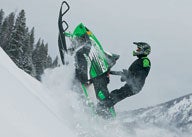
Unchanged, unbridled, uncompromised
We defy you to find fault with Arctic Cat’s M8 line. We challenge you to say, “It’s outdated.” What’s that we hear? Oh, such silence.
OK, we admit Polaris’ Pro Ride RMK for 2011 delivers a challenge to Arctic Cat that its M8 may no longer be the light and nimble standard for mountain-specific snowmobiles — 2011 is the season for truths. Additionally, Ski-Doo stepped into the foray by introducing a Summit and Everest with that needed “sweet spot” for sidehilling, boondocking and tree running. This is exciting.
But Arctic Cat remains the target the others aim at. For 2011 the M8 comes in three models: Standard (153 and 162), Sno Pro (153 and 162) and HCR (153) for Hill Climb Racer. There is a limited build Sno Pro LTD (Limited) 153 that sports all the Sno Pro amenities, but has its own unique dark sublime green color and other gadgets. Regardless, all M8s come equipped with Cat’s 800cc HO (High Output) motor, electronic reverse, lightweight seat, Fox Float Rear Skid and Power Claw track.
History Lesson
In 2009 Cat introduced an M8 dressed in a lighter tunnel with bobbed tail. Lighter components on the front and rear suspension, reduced rotating mass, electronic reverse, and telescoping handlebars made 2009 the year Cat stepped deep into building a single-purpose mountain snowmobile. In a niche where weight rules, the 2009 M8 dropped 22-pounds from the 2008 model.
In 2010 the M8 retained the 2009 enhancements, but came with the H.O. motor rated at 163 horsepower. For 2010, Cat had the best power-to-weight ratio for all brand and model 800 class mountain snowmobiles. So for 2011, as was the case for 2010, all M8s — Standard, Sno Pro (including Sno Pro LTD) and HCR — has the Cat-designed and Suzuki-built H.O. 800 as standard equipment.
The Power
The 800 is a Twin cylinder, two-stroke motor with battery-less electronic fuel injection (EFI) that adjusts fuel flow for altitude, barometric pressure, and throttle position. Its bore is 85mm with a 70mm stroke. The throttle bodies dumping the fuel charge into the cylinders are large bore, measuring 46mm. The motor uses Cat’s electronic exhaust valves (Arctic Power Valves — APV) and has an Exhaust Pipe Temperature Sensor (EPTS) that sends warning signs to the driver if need be. In each chug, two spark plugs (for a total of four) ignite the fuel and oxygen combination as it succumbs to cylinder head pressure. On the motor’s induction side, reed petals allow air to smoothly swirl into the motor. Under the tunnel, each M8 spins the Power Claw track. This 80-durometer (90-durometer for the HCR), 15-inch wide track, with lugs measuring 2.25-inches tall, is probably the best deep powder track on the market. This track allows the M to launch hard, claw voraciously and float effortlessly through the powder; it is a non-ported track. Ski stance for all M8s (except for the HCR) is adjustable from 39-inches to 41-inches. All Ms feature a non-torsion spring rear suspension. According to Arctic Cat, “The frame decreases unsprung weight and reduces track tensioning. Better track flexibility and sidehillIng capabilities with two rear-mounted wheels inside the rails.” Lastly, all Ms come with Cat’s own lightweight teardrop style seat that is tall with deep and ample storage, something the other Original Equipment Manufacturers (OEMs) have forgotten. On the hood, FrogzSkin material covers the hood vents. This material allows air to flow under the hood while halting snow throughput. One thing to know, the 800 H.O. exhaust system is the same exhaust system used on the M1000. When strong horsepower and torque are built, decibels also increase, hence a fat pipe with gobs of insulation are needed to bring the noise level down. This pipe is by no means light. Most hardcore mountain riders will rip out this pipe and install a lighter single tuner. M8 Standard The Standard M8 has all the above, but is constructed without Cat’s famous 12-position telescoping handlebars, which is unique to Arctic Cat. The bars are fixed on the Standard, just as the other OEM bars are fixed on their mountain snowmobiles. Track lengths for the Standard are 153 and 162-inches. The front suspension is the Arctic Wishbone System (AWS™) VI with lightweight aluminum FOX Zero Pro gas internal floating piston (IFP) shocks. The rear suspension is the Fox Float Arctic Cat Technology (ACT) rear skid utilizing a lightweight aluminum FOX Zero Pro IFP shock on the front arm with adjustable preload springs. The instrument pod is a digital/analog unit that displays RPM, ground speed, and trip distance. The pod also has warning lights for low oil and high coolant temps. Color for the Standard M8 is green and white on a black hood. Prices for the two Standard Ms are US $10,999 and CAN $12,999 for the 153; and US $11,299 and CAN $13,399 for the 162. M8 Sno Pro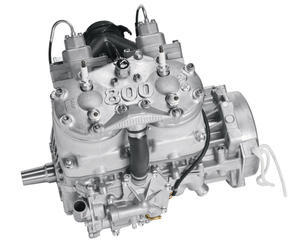
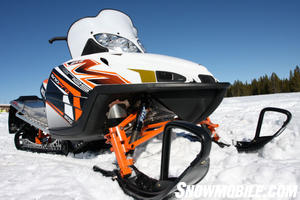 The 2011 Arctic Cat M8 Sno Pro has one of the best mountain specific chassis ever built.
The 2011 Arctic Cat M8 Sno Pro has one of the best mountain specific chassis ever built.
Like the Standard, the Sno Pro comes in a 153 and 162, but has a premium shock package for weight reduction, telescoping handlebars for extreme boondocking, and an instrument cluster that goes beyond normal.
The AWS front suspension uses FOX Float AirShox without external adjustable coil-over springs. The M series rear skid uses a lightweight aluminum FOX Zero Pro IFP shock on front arm, with lightweight FOX Float AirShox on rear arm.
For the FOX Float AirShox, we have been critical of the shocks’ overly stiff stock setup calibration. In the deep powder, the harshness is not noticeable, but when whumping the whoops, it seemed the shocks had no dampening; every mogul hit transmitted its energy up through the handlebars and tunnel. Cat called upon one of its hillclimb racer’s, Todd Tupper, to tune the AirShox to a gentle compression, facsimile to a rising rate (or dual rate spring); the valving for the AirShox used on the M Sno Pro is a Cat exclusive. The AirShox are now gentle through the chatter bumps and will stiffen, at a linear rate, when shock compression becomes more severe (the mogul swells become deeper). This small improvement is huge for the M Sno Pro, as we have criticized Cat for this model for being unfavorable on the trails. In fact, the Standard M8 was a more controlled M than the Sno Pro, and some consumers were miffed for purchasing a premium sled that handled worse than the budget M8.
Kale Wainer, Cat’s Media Manager explained, “Our customers were pretty opinionated that our mountain sleds were the best performing, but the one thing they wanted improved was the trail ride capabilities. So, we went in, worked on the valving in the shocks and came up with a package we were happy with on the trails, and after further off-trail testing found that the shock packages improved the climbing ability of the Cats.” Specific valve specs are posted on Cat’s website.
The Limited’s function is to carry the rider farther away from his truck because said rider knows he has stuffed his shop into the LTD’s storage bags. But here is the sanity check, it looks good. The extra storage is not unsightly, but is fashionable and not a hindrance to the driver.
The LTD too, has Cat’s new shock valve package.
Arctic Cat has a suggested price of US $11,999 and CAN $14,299.
HCR
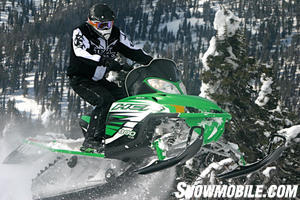 The HCR with its standard Power Claw track makes it one of the best sleds on any mountain.
The HCR with its standard Power Claw track makes it one of the best sleds on any mountain.
The HCR, like its fellow Sno Pro, is a premium mountain sled with an affinity for hill climb completion. It only comes in a 153. At its nose, the front suspension corners on FOX Zero Pro gas IFP shocks with adjustable preload titanium springs, these springs are an HCR exclusive. Its ski stance is adjustable from 42-inches to 44-inches; a wide stance helps the competitive hillclimber stay flat when carving around gates on a timed hill climb course.
The HCR uses the same telescoping handlebars and instrument cluster as the Sno Pro. But its biggest differences are the stiffer 90-duometer track that is designed to hook up on rocks, granite, dirt and grandma’s rocking chair — the stiffer paddles resist folding on packed snow, and its narrow race-inspired skis are adept for sharp turning, but marginal in delivering floatation when swimming through deep powder.
There are times when the stiffer track outperforms the softer durometer track used on the Standard and Sno Pro, this occurs when the snow is hard or is slightly set, giving the 90-duo track the base it wants to pull faster times up a mountain slope than its siblings. The HCR track is similar in stiffness to Camoplast’s Challenger track. We have proved this in our timed uphill climbs, as the course hardens the HCR handily eclipses the Sno Pro. We have often heard from new M pilots, “The HCR must have an EFI map different than the Sno Pro, it blasts so fast out of a hole.” Nope, motor and mapping are the same, but the track is a happy hooker on hard pack snow.
Conversely, the Sno Pro in panic-button deep powder, teaches the HCR how to hit a mountain’s crown, the softer track does not blow out the snow.
Color for the HCR is a light lime green with black and white highlights. Suggested OEM cost for the HCR is US $12,299 and CAN $14,499.
Final Thoughts
Mountain busting on Cat’s M8 is stupid fun. The M8s are proficient and expert to steep-and-deep boondocking, ravine bashing and tree running. The traction-savvy runningboards, flat handlebar swing (vertical steering post that is behind and under the motor), low central mass, direct drive and sweet “flickability” give it an A+ rating. In the competitive steep-and-deep game, the M8 and M8 Sno Pro, with its superb 80-durometer 2.25-inch Power Claw track, exceptional balance, and deep snow-float ability may continue to be the standard bearer for 2011. But, this may change with the new Pro Ride RMK 800 or with the Summit due to its new front end and E-Tec motor.
Not to be left alone, the 153 HCR spinning the stiffer 90-durometer 2.25-inch Power Claw track should continue to place racers on the podium, but it has stiff competition from the Summit Free Ride and Assault RMK.
The H.O. motor is strong, reliable and has a wide and torque-filled powerband. The M8’s fit and finish is not as clean as the other manufacturers’ products. Not by much, but noticeable to the experienced eye. Last season, our M8 162 Sno Pro never faltered. In fact, in all the years we have tested Cat’s M8, we have never, ever had an engine, clutch, suspension, or chassis failure. Even though the M’s appearance is familiar, debuting on the M7, the M8 remains a good looking snowmobile with a much refined and lightened chassis. To gain model-year 2011 insight, read about our 2010 M8 and how it performed for Snowmobile.com. Scan our mid-season report, Shoot-out report and our season-long evaluation report. With the 2011 M8 being a 2010 with improved handling from better calibrated shocks (on the Sno Pro editions only), you can make an informed decision whether or not the M8 is the product for your needs. At the model-year 2011 evaluations, Cat made it clear to the press, its M8 Sno Pro 153 was the best selling mountain snowmobile for model-year 2010; it owned, depending on Rocky Mountain region, 50% to 60% market share over the other OEM mountain models. Also, the M8 Sno Pro 153 was Arctic Cat’s best selling snowmobile for 2010 – a first for Cat’s mountain line. Cat markets its M-Series at Expert Grade. We concur. Second Opinions: Kevin Allred, Sr. Mountain Snowmobile Test Rider Since its birth, the M8 has been a favorite with us. Like I wrote in our season-end report on the 2010 M8, “ …we learned this March in West Yellowstone at the Annual Snow Shoot, [and one important item] was the M8 was a favorite with the Western rider as well; it was the biggest selling model for Arctic Cat and the number one selling mountain sled in the West.” Why the large sales volume in a poor economy? The HO 800 motor. This motor hits hard and never flattens out as it runs through its power curve. I have absolute confidence in the M8. It supports me in the most difficult and technical situations without complaining, and it pulls me through these knee knocking and nail biting situations with simplicity. The recalibrated shocks on the rear skid are welcome with noticeable improvement. Though after a season on the 2010 media demo sleds from Arctic Cat, Polaris, and Yamaha, I’m less critical of the ride on the Ms. Like Jake and Matt, I still like the looks of the M, though it’s now becoming somewhat dated. The M8’s dominance from last year is now facing new alloy from Polaris (Pro-Ride RMK) and a much-improved Summit from Ski Doo — game changers could be in the works. But time tested reliability, handling and power, and what I consider the best mountain track in the industry is worth much when considering a new ride for 2011. Also, I appreciate the M8’s storage. Nice. Another Opinion: Jake Allred, Mountain Sled Photographer and Test Rider I disagree with Matt on the M’s fit and finish; I believe it is as good as the other OEMs. I think the M8 has the coolest looking rail, running boards, and tunnel in general. I like the rear light and the snow flap combo, the seat looks nice and functional; I love the look of the M. The Arctic Cat M8 comes to MY2011 with some steep competition. The M8 still has superior horsepower and a superior track, but that might not be enough to beat out a new lightweight chassis from Polaris, and new front-end geometry from Ski-Doo on its Summit. Even though the M8 is in its sixth year, it is still one of the user-friendliest chassis out there. Cat engineers have proven they have what it takes to build a solid and respected mountain sled. The question is whether Cat can continue building a chassis that makes mountain riders happy, or a sled that makes the shareholders happy. Mountains or beans. Related Reading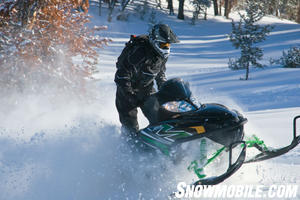
2010 Arctic Cat M8 Review
Mid-Season Powder Sled Report
2010 Mountain Sled Report Card – Part One
2010 Mountain Sled Report Card – Part Two
2010 Mountain Sled Evaluation – Part One
2010 Mountain Sled Evaluation – Part Two



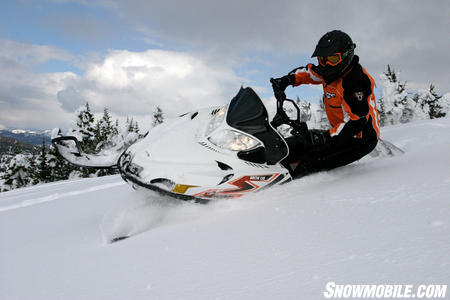
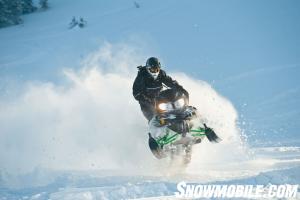
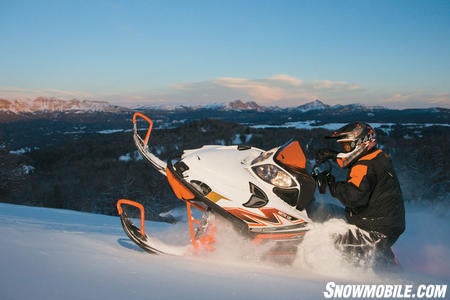
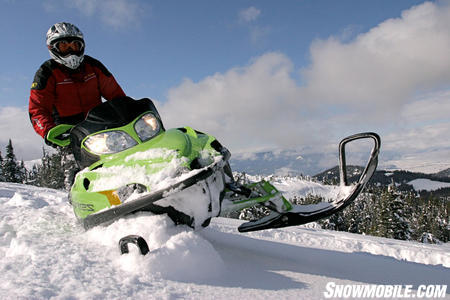
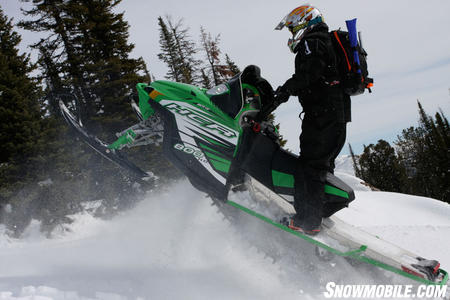
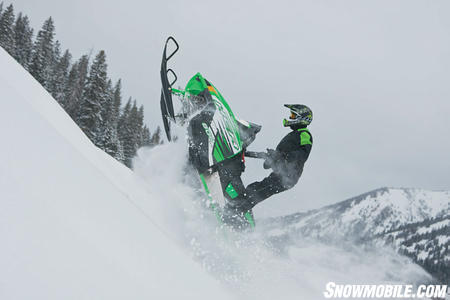
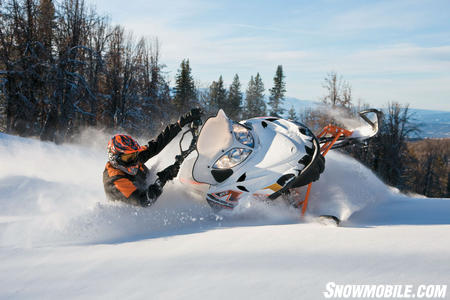





 Your Privacy Choices
Your Privacy Choices